Neuropsychology Report: Brain Dysfunction, Memory Loss, and Symptoms
VerifiedAdded on 2020/10/23
|8
|2244
|495
Report
AI Summary
This report delves into the field of neuropsychology, exploring the intricate relationship between brain dysfunction and neuropsychological symptoms, particularly those stemming from brain injuries. The reflective section focuses on memory loss, detailing its various symptoms and the emotional and cognitive challenges faced by individuals experiencing such impairments. The analytical section meticulously examines the brain regions responsible for executive dysfunction, primarily the frontal lobes, and elucidates the specific neural processes that are compromised in these conditions. The report further discusses the impact of injuries on different parts of the frontal lobe, leading to varying degrees of impairment. It also explores the mechanisms of impaired neural processing, including axonal damage and its consequences. The report concludes by emphasizing the importance of early detection and intervention for individuals with brain injuries and neuropsychological symptoms, highlighting the need for further research to better understand and address these complex conditions.
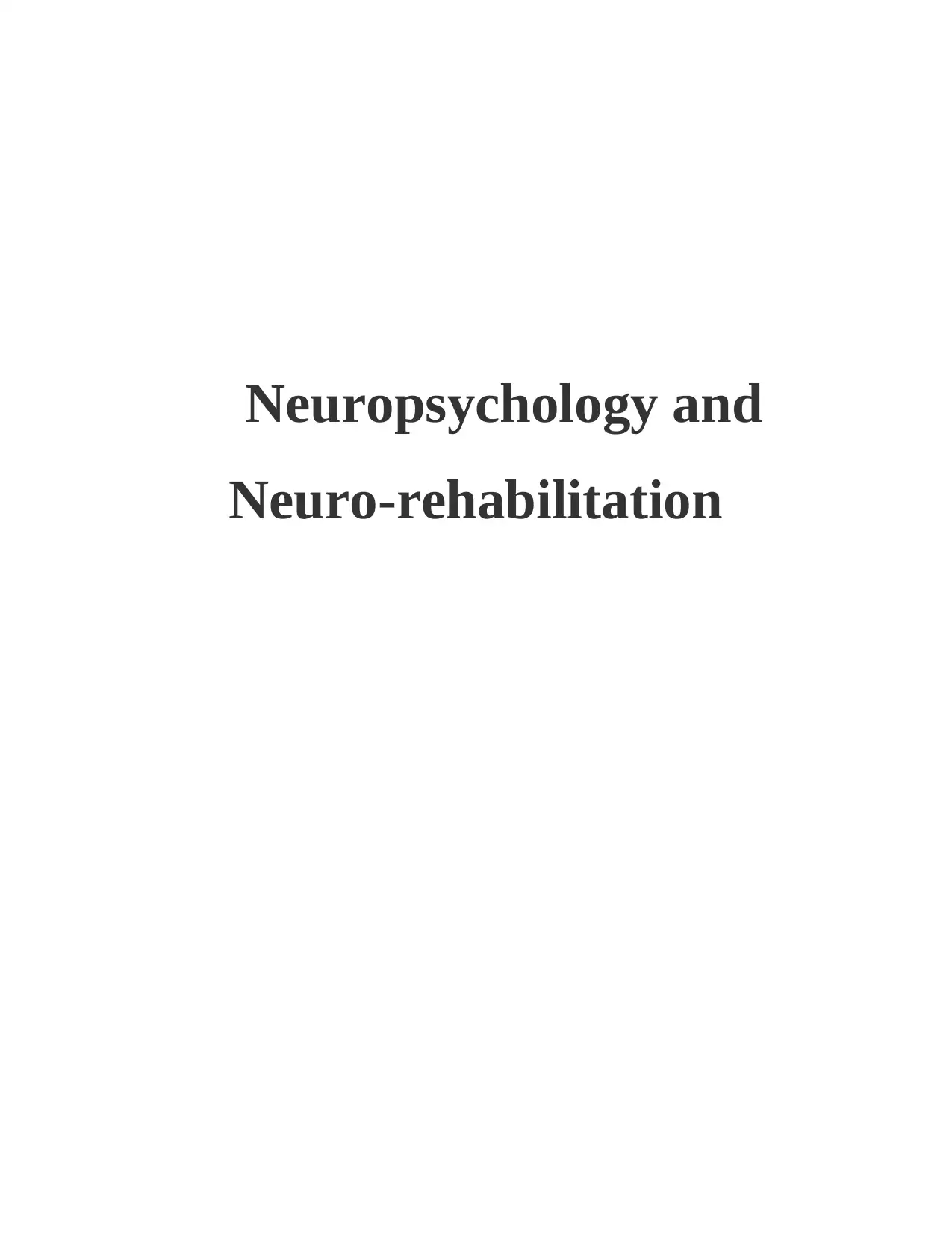
Neuropsychology and
Neuro-rehabilitation
Neuro-rehabilitation
Paraphrase This Document
Need a fresh take? Get an instant paraphrase of this document with our AI Paraphraser

TABLE OF CONTENTS
INTRODUCTION..........................................................................................................................1
REFLECTIVE SECTION ...............................................................................................................1
Memory loss symptoms .............................................................................................................1
ANALYTICAL SECTION .............................................................................................................2
Brain regions responsible for executive dysfunction .................................................................2
Impaired neural processing involved in the impairment ............................................................4
CONCLUSION ...............................................................................................................................5
REFERENCES ...............................................................................................................................6
INTRODUCTION..........................................................................................................................1
REFLECTIVE SECTION ...............................................................................................................1
Memory loss symptoms .............................................................................................................1
ANALYTICAL SECTION .............................................................................................................2
Brain regions responsible for executive dysfunction .................................................................2
Impaired neural processing involved in the impairment ............................................................4
CONCLUSION ...............................................................................................................................5
REFERENCES ...............................................................................................................................6
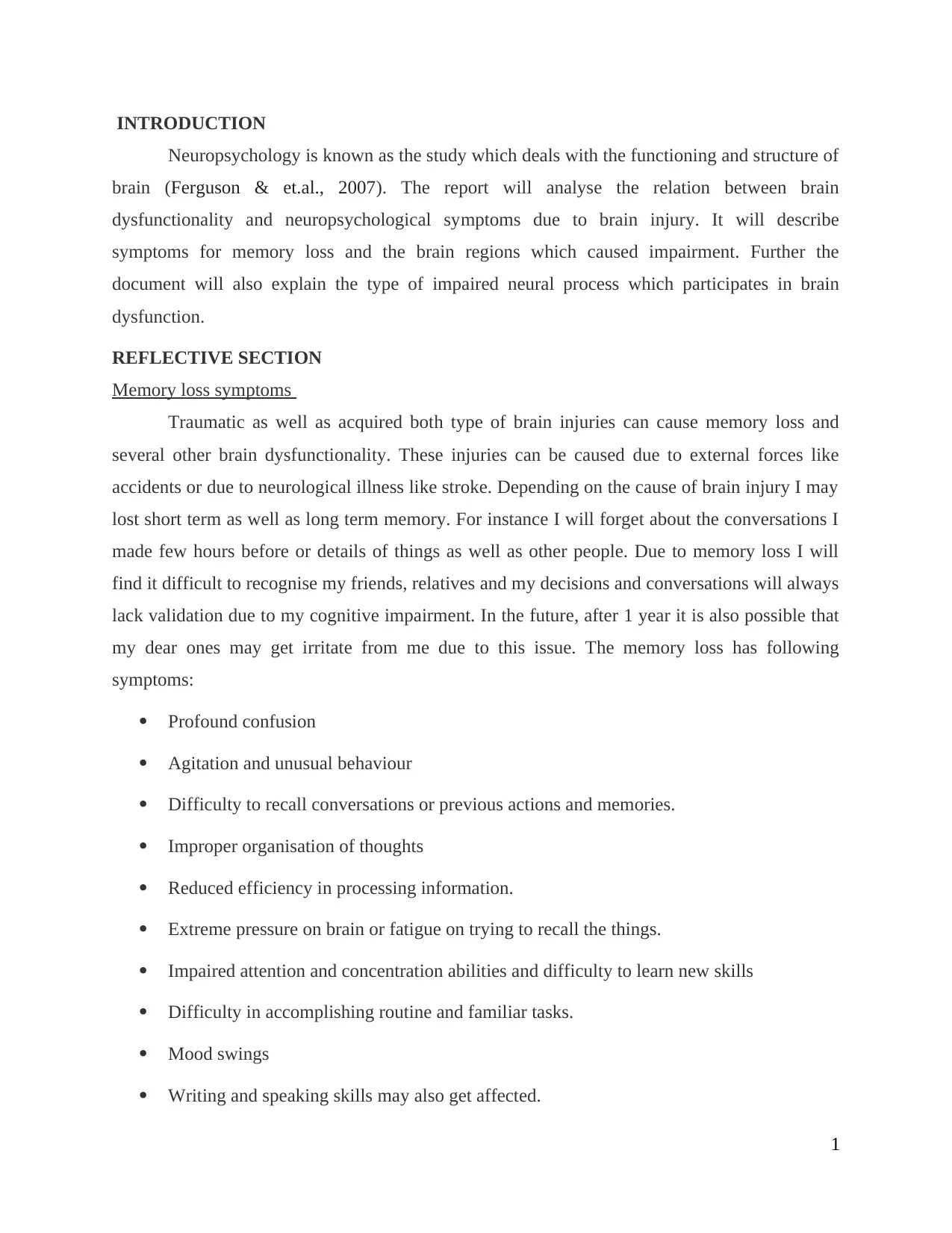
INTRODUCTION
Neuropsychology is known as the study which deals with the functioning and structure of
brain (Ferguson & et.al., 2007). The report will analyse the relation between brain
dysfunctionality and neuropsychological symptoms due to brain injury. It will describe
symptoms for memory loss and the brain regions which caused impairment. Further the
document will also explain the type of impaired neural process which participates in brain
dysfunction.
REFLECTIVE SECTION
Memory loss symptoms
Traumatic as well as acquired both type of brain injuries can cause memory loss and
several other brain dysfunctionality. These injuries can be caused due to external forces like
accidents or due to neurological illness like stroke. Depending on the cause of brain injury I may
lost short term as well as long term memory. For instance I will forget about the conversations I
made few hours before or details of things as well as other people. Due to memory loss I will
find it difficult to recognise my friends, relatives and my decisions and conversations will always
lack validation due to my cognitive impairment. In the future, after 1 year it is also possible that
my dear ones may get irritate from me due to this issue. The memory loss has following
symptoms:
Profound confusion
Agitation and unusual behaviour
Difficulty to recall conversations or previous actions and memories.
Improper organisation of thoughts
Reduced efficiency in processing information.
Extreme pressure on brain or fatigue on trying to recall the things.
Impaired attention and concentration abilities and difficulty to learn new skills
Difficulty in accomplishing routine and familiar tasks.
Mood swings
Writing and speaking skills may also get affected.
1
Neuropsychology is known as the study which deals with the functioning and structure of
brain (Ferguson & et.al., 2007). The report will analyse the relation between brain
dysfunctionality and neuropsychological symptoms due to brain injury. It will describe
symptoms for memory loss and the brain regions which caused impairment. Further the
document will also explain the type of impaired neural process which participates in brain
dysfunction.
REFLECTIVE SECTION
Memory loss symptoms
Traumatic as well as acquired both type of brain injuries can cause memory loss and
several other brain dysfunctionality. These injuries can be caused due to external forces like
accidents or due to neurological illness like stroke. Depending on the cause of brain injury I may
lost short term as well as long term memory. For instance I will forget about the conversations I
made few hours before or details of things as well as other people. Due to memory loss I will
find it difficult to recognise my friends, relatives and my decisions and conversations will always
lack validation due to my cognitive impairment. In the future, after 1 year it is also possible that
my dear ones may get irritate from me due to this issue. The memory loss has following
symptoms:
Profound confusion
Agitation and unusual behaviour
Difficulty to recall conversations or previous actions and memories.
Improper organisation of thoughts
Reduced efficiency in processing information.
Extreme pressure on brain or fatigue on trying to recall the things.
Impaired attention and concentration abilities and difficulty to learn new skills
Difficulty in accomplishing routine and familiar tasks.
Mood swings
Writing and speaking skills may also get affected.
1
⊘ This is a preview!⊘
Do you want full access?
Subscribe today to unlock all pages.

Trusted by 1+ million students worldwide
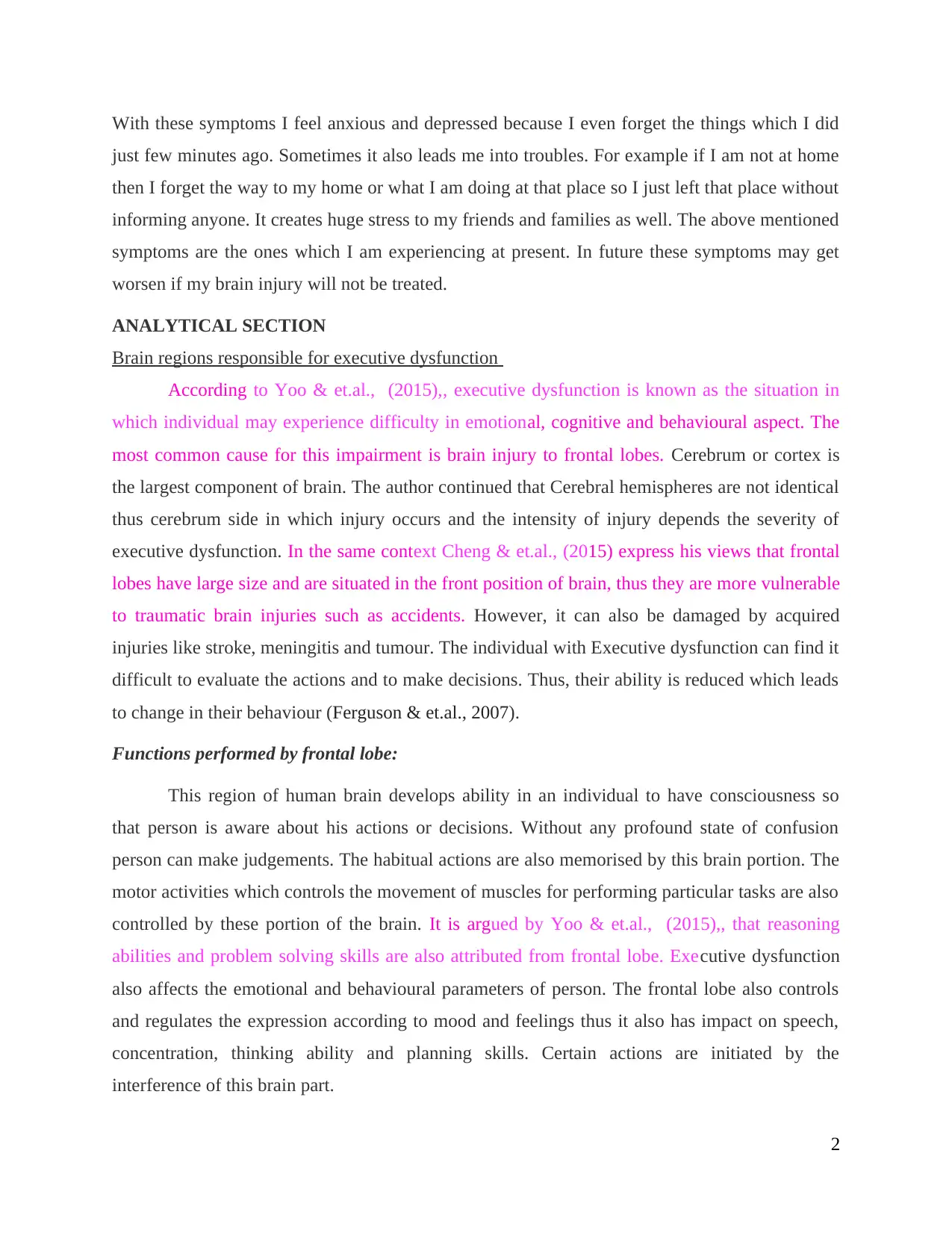
With these symptoms I feel anxious and depressed because I even forget the things which I did
just few minutes ago. Sometimes it also leads me into troubles. For example if I am not at home
then I forget the way to my home or what I am doing at that place so I just left that place without
informing anyone. It creates huge stress to my friends and families as well. The above mentioned
symptoms are the ones which I am experiencing at present. In future these symptoms may get
worsen if my brain injury will not be treated.
ANALYTICAL SECTION
Brain regions responsible for executive dysfunction
According to Yoo & et.al., (2015),, executive dysfunction is known as the situation in
which individual may experience difficulty in emotional, cognitive and behavioural aspect. The
most common cause for this impairment is brain injury to frontal lobes. Cerebrum or cortex is
the largest component of brain. The author continued that Cerebral hemispheres are not identical
thus cerebrum side in which injury occurs and the intensity of injury depends the severity of
executive dysfunction. In the same context Cheng & et.al., (2015) express his views that frontal
lobes have large size and are situated in the front position of brain, thus they are more vulnerable
to traumatic brain injuries such as accidents. However, it can also be damaged by acquired
injuries like stroke, meningitis and tumour. The individual with Executive dysfunction can find it
difficult to evaluate the actions and to make decisions. Thus, their ability is reduced which leads
to change in their behaviour (Ferguson & et.al., 2007).
Functions performed by frontal lobe:
This region of human brain develops ability in an individual to have consciousness so
that person is aware about his actions or decisions. Without any profound state of confusion
person can make judgements. The habitual actions are also memorised by this brain portion. The
motor activities which controls the movement of muscles for performing particular tasks are also
controlled by these portion of the brain. It is argued by Yoo & et.al., (2015),, that reasoning
abilities and problem solving skills are also attributed from frontal lobe. Executive dysfunction
also affects the emotional and behavioural parameters of person. The frontal lobe also controls
and regulates the expression according to mood and feelings thus it also has impact on speech,
concentration, thinking ability and planning skills. Certain actions are initiated by the
interference of this brain part.
2
just few minutes ago. Sometimes it also leads me into troubles. For example if I am not at home
then I forget the way to my home or what I am doing at that place so I just left that place without
informing anyone. It creates huge stress to my friends and families as well. The above mentioned
symptoms are the ones which I am experiencing at present. In future these symptoms may get
worsen if my brain injury will not be treated.
ANALYTICAL SECTION
Brain regions responsible for executive dysfunction
According to Yoo & et.al., (2015),, executive dysfunction is known as the situation in
which individual may experience difficulty in emotional, cognitive and behavioural aspect. The
most common cause for this impairment is brain injury to frontal lobes. Cerebrum or cortex is
the largest component of brain. The author continued that Cerebral hemispheres are not identical
thus cerebrum side in which injury occurs and the intensity of injury depends the severity of
executive dysfunction. In the same context Cheng & et.al., (2015) express his views that frontal
lobes have large size and are situated in the front position of brain, thus they are more vulnerable
to traumatic brain injuries such as accidents. However, it can also be damaged by acquired
injuries like stroke, meningitis and tumour. The individual with Executive dysfunction can find it
difficult to evaluate the actions and to make decisions. Thus, their ability is reduced which leads
to change in their behaviour (Ferguson & et.al., 2007).
Functions performed by frontal lobe:
This region of human brain develops ability in an individual to have consciousness so
that person is aware about his actions or decisions. Without any profound state of confusion
person can make judgements. The habitual actions are also memorised by this brain portion. The
motor activities which controls the movement of muscles for performing particular tasks are also
controlled by these portion of the brain. It is argued by Yoo & et.al., (2015),, that reasoning
abilities and problem solving skills are also attributed from frontal lobe. Executive dysfunction
also affects the emotional and behavioural parameters of person. The frontal lobe also controls
and regulates the expression according to mood and feelings thus it also has impact on speech,
concentration, thinking ability and planning skills. Certain actions are initiated by the
interference of this brain part.
2
Paraphrase This Document
Need a fresh take? Get an instant paraphrase of this document with our AI Paraphraser
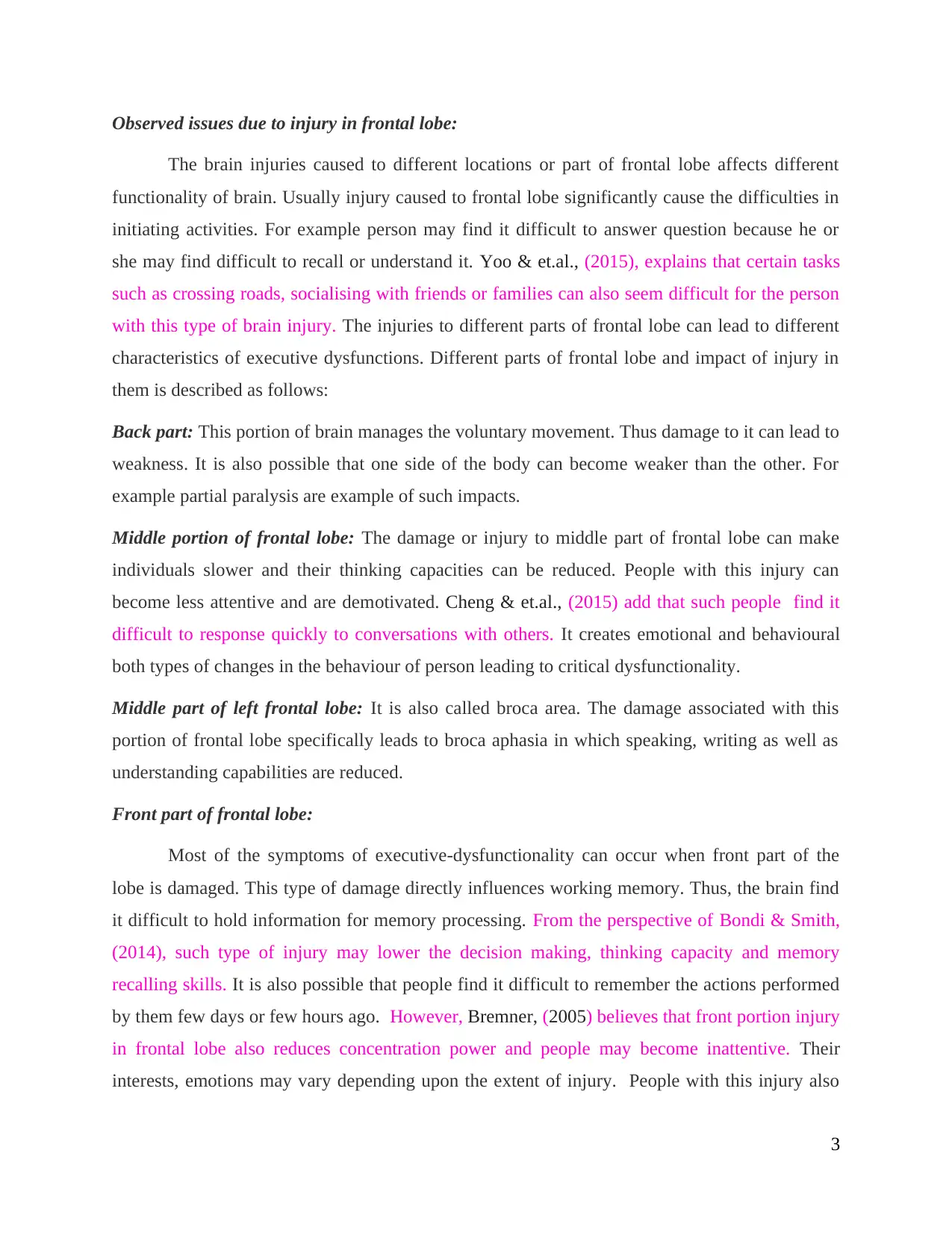
Observed issues due to injury in frontal lobe:
The brain injuries caused to different locations or part of frontal lobe affects different
functionality of brain. Usually injury caused to frontal lobe significantly cause the difficulties in
initiating activities. For example person may find it difficult to answer question because he or
she may find difficult to recall or understand it. Yoo & et.al., (2015), explains that certain tasks
such as crossing roads, socialising with friends or families can also seem difficult for the person
with this type of brain injury. The injuries to different parts of frontal lobe can lead to different
characteristics of executive dysfunctions. Different parts of frontal lobe and impact of injury in
them is described as follows:
Back part: This portion of brain manages the voluntary movement. Thus damage to it can lead to
weakness. It is also possible that one side of the body can become weaker than the other. For
example partial paralysis are example of such impacts.
Middle portion of frontal lobe: The damage or injury to middle part of frontal lobe can make
individuals slower and their thinking capacities can be reduced. People with this injury can
become less attentive and are demotivated. Cheng & et.al., (2015) add that such people find it
difficult to response quickly to conversations with others. It creates emotional and behavioural
both types of changes in the behaviour of person leading to critical dysfunctionality.
Middle part of left frontal lobe: It is also called broca area. The damage associated with this
portion of frontal lobe specifically leads to broca aphasia in which speaking, writing as well as
understanding capabilities are reduced.
Front part of frontal lobe:
Most of the symptoms of executive-dysfunctionality can occur when front part of the
lobe is damaged. This type of damage directly influences working memory. Thus, the brain find
it difficult to hold information for memory processing. From the perspective of Bondi & Smith,
(2014), such type of injury may lower the decision making, thinking capacity and memory
recalling skills. It is also possible that people find it difficult to remember the actions performed
by them few days or few hours ago. However, Bremner, (2005) believes that front portion injury
in frontal lobe also reduces concentration power and people may become inattentive. Their
interests, emotions may vary depending upon the extent of injury. People with this injury also
3
The brain injuries caused to different locations or part of frontal lobe affects different
functionality of brain. Usually injury caused to frontal lobe significantly cause the difficulties in
initiating activities. For example person may find it difficult to answer question because he or
she may find difficult to recall or understand it. Yoo & et.al., (2015), explains that certain tasks
such as crossing roads, socialising with friends or families can also seem difficult for the person
with this type of brain injury. The injuries to different parts of frontal lobe can lead to different
characteristics of executive dysfunctions. Different parts of frontal lobe and impact of injury in
them is described as follows:
Back part: This portion of brain manages the voluntary movement. Thus damage to it can lead to
weakness. It is also possible that one side of the body can become weaker than the other. For
example partial paralysis are example of such impacts.
Middle portion of frontal lobe: The damage or injury to middle part of frontal lobe can make
individuals slower and their thinking capacities can be reduced. People with this injury can
become less attentive and are demotivated. Cheng & et.al., (2015) add that such people find it
difficult to response quickly to conversations with others. It creates emotional and behavioural
both types of changes in the behaviour of person leading to critical dysfunctionality.
Middle part of left frontal lobe: It is also called broca area. The damage associated with this
portion of frontal lobe specifically leads to broca aphasia in which speaking, writing as well as
understanding capabilities are reduced.
Front part of frontal lobe:
Most of the symptoms of executive-dysfunctionality can occur when front part of the
lobe is damaged. This type of damage directly influences working memory. Thus, the brain find
it difficult to hold information for memory processing. From the perspective of Bondi & Smith,
(2014), such type of injury may lower the decision making, thinking capacity and memory
recalling skills. It is also possible that people find it difficult to remember the actions performed
by them few days or few hours ago. However, Bremner, (2005) believes that front portion injury
in frontal lobe also reduces concentration power and people may become inattentive. Their
interests, emotions may vary depending upon the extent of injury. People with this injury also
3

find it difficult to respond quickly to conversations because they may feel difficult to understand
and thoughts can be processed slowly. According to Rigon & et.al., (2016) these factors can also
leads to emotional trauma and psychological stress because the sufferer may feel depressed or
ashamed to face his social group and carers.
Summarisation of symptoms of executive-dysfunction resulting due to frontal lobe injury:
The frontal lobe injury can result in following symptoms of executive-dysfunctionality.
Problems in organising and initiating activities.
Rigid behaviour so that person may resist adopting changes and is highly confined with
the practices according to him.
Impulsive behaviour and quick mood swings.
Difficulties in memorisation, in learning new concepts as well as to recall past activities.
Impaired neural processing involved in the impairment
The brain consist of huge network of nerves and when brain injuries are occurred any of
the nerves can traumatized or damage. It can lead to brain dysfunctionality. The central nervous
system consist of brain and spinal-cord. From brain nerves are distributed to all over body which
processes neuron signals to accomplish the normal body functioning (Morecraft & et.al., 2016).
Similarly, Shanmugan & et.al., (2016), stated that the cerebral cortex consist of good number of
wrinkles which increases the surface area covered by brain and thus more number of neurons can
exist within it. Post brain injuries the self awareness is reduced among people. The fronto
parietal controlling network which regulates and monitors the neural activities becomes
abnormal in people with brain injuries.
The cerebral cortex is an element of this network and hence the injury can affect the
neural processing. The brain injuries can cause diffusion of traumatic brain injury to the sites
where diffusion of axonal injuries can occur. As a result axonal can be swollen or in case of
severe damage can disconnect. In the view of Ferguson & et.al., (2007) this disconnection leads
to rapid initiation of secondary brain damage due to multi factorial mechanism. Hence, axon
pathology began to change. During the brain injuries when acceleration, brain rotation and
deceleration occurs then shear tensile forces are generated. These forces develop direct severing
of axon. This effect is known as primary axotomy.
4
and thoughts can be processed slowly. According to Rigon & et.al., (2016) these factors can also
leads to emotional trauma and psychological stress because the sufferer may feel depressed or
ashamed to face his social group and carers.
Summarisation of symptoms of executive-dysfunction resulting due to frontal lobe injury:
The frontal lobe injury can result in following symptoms of executive-dysfunctionality.
Problems in organising and initiating activities.
Rigid behaviour so that person may resist adopting changes and is highly confined with
the practices according to him.
Impulsive behaviour and quick mood swings.
Difficulties in memorisation, in learning new concepts as well as to recall past activities.
Impaired neural processing involved in the impairment
The brain consist of huge network of nerves and when brain injuries are occurred any of
the nerves can traumatized or damage. It can lead to brain dysfunctionality. The central nervous
system consist of brain and spinal-cord. From brain nerves are distributed to all over body which
processes neuron signals to accomplish the normal body functioning (Morecraft & et.al., 2016).
Similarly, Shanmugan & et.al., (2016), stated that the cerebral cortex consist of good number of
wrinkles which increases the surface area covered by brain and thus more number of neurons can
exist within it. Post brain injuries the self awareness is reduced among people. The fronto
parietal controlling network which regulates and monitors the neural activities becomes
abnormal in people with brain injuries.
The cerebral cortex is an element of this network and hence the injury can affect the
neural processing. The brain injuries can cause diffusion of traumatic brain injury to the sites
where diffusion of axonal injuries can occur. As a result axonal can be swollen or in case of
severe damage can disconnect. In the view of Ferguson & et.al., (2007) this disconnection leads
to rapid initiation of secondary brain damage due to multi factorial mechanism. Hence, axon
pathology began to change. During the brain injuries when acceleration, brain rotation and
deceleration occurs then shear tensile forces are generated. These forces develop direct severing
of axon. This effect is known as primary axotomy.
4
⊘ This is a preview!⊘
Do you want full access?
Subscribe today to unlock all pages.

Trusted by 1+ million students worldwide

When traumatic injuries are moderate and mild then secondary swelling and
disconnection of axon occurs which is known as the secondary axotomy. Bremner, (2005)
discuss that the key mechanism behind secondary axotomy is the disruption caused due to
primary swelling and destortion of axoplasmic cytoskeletal component. The progression of
neurological changes depends upon the type and severity of the injury along with the location of
brain injury. The knowledge of these neurological changes which are reflected due to injury can
cause long term cognitive impairment as well as difficulty in performing motor activities which
involves the muscular movement. Thus, it is observed that traumatic brain injuries are
characterised with deviations in functional and structural connectivity. It decreases the integrity
of imbalance and efficiency of functional network. These deviations are associated with the
dysfunctionality which results from neurocognitive effect as discussed above. The changes to
neurological processing during brain functioning impairment can cause behavioural disturbances.
These injuries not only affect the functionality of neural network but it also affects its ability to
recover and reconstitute (Ferguson & et.al., 2007).
CONCLUSION
The report has explained the neuropsychological symptoms for memory loss. It has also
described the neuro signal processing of brain regions which leads to executive-dysfunction. Thu
it can be concluded from the report that brain regions are very sensitive. The brain injuries and
neuropsychological symptoms must be immediately reported to the health professionals. It is
essential for the researches to analyse the neurological dysfunctionality so that more detailed
analysis can be made for the brain functions which are responsible for impairment.
5
disconnection of axon occurs which is known as the secondary axotomy. Bremner, (2005)
discuss that the key mechanism behind secondary axotomy is the disruption caused due to
primary swelling and destortion of axoplasmic cytoskeletal component. The progression of
neurological changes depends upon the type and severity of the injury along with the location of
brain injury. The knowledge of these neurological changes which are reflected due to injury can
cause long term cognitive impairment as well as difficulty in performing motor activities which
involves the muscular movement. Thus, it is observed that traumatic brain injuries are
characterised with deviations in functional and structural connectivity. It decreases the integrity
of imbalance and efficiency of functional network. These deviations are associated with the
dysfunctionality which results from neurocognitive effect as discussed above. The changes to
neurological processing during brain functioning impairment can cause behavioural disturbances.
These injuries not only affect the functionality of neural network but it also affects its ability to
recover and reconstitute (Ferguson & et.al., 2007).
CONCLUSION
The report has explained the neuropsychological symptoms for memory loss. It has also
described the neuro signal processing of brain regions which leads to executive-dysfunction. Thu
it can be concluded from the report that brain regions are very sensitive. The brain injuries and
neuropsychological symptoms must be immediately reported to the health professionals. It is
essential for the researches to analyse the neurological dysfunctionality so that more detailed
analysis can be made for the brain functions which are responsible for impairment.
5
Paraphrase This Document
Need a fresh take? Get an instant paraphrase of this document with our AI Paraphraser
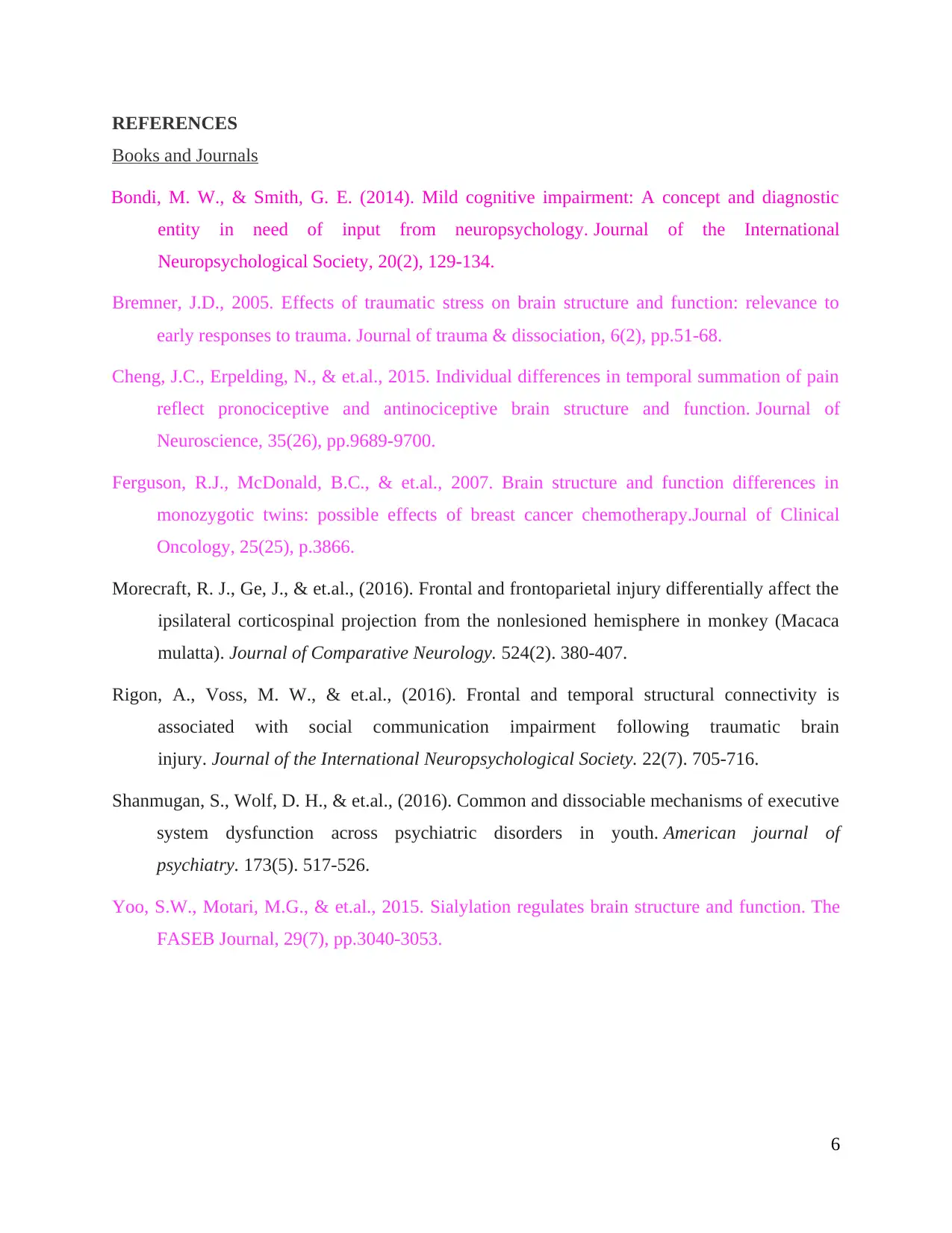
REFERENCES
Books and Journals
Bondi, M. W., & Smith, G. E. (2014). Mild cognitive impairment: A concept and diagnostic
entity in need of input from neuropsychology. Journal of the International
Neuropsychological Society, 20(2), 129-134.
Bremner, J.D., 2005. Effects of traumatic stress on brain structure and function: relevance to
early responses to trauma. Journal of trauma & dissociation, 6(2), pp.51-68.
Cheng, J.C., Erpelding, N., & et.al., 2015. Individual differences in temporal summation of pain
reflect pronociceptive and antinociceptive brain structure and function. Journal of
Neuroscience, 35(26), pp.9689-9700.
Ferguson, R.J., McDonald, B.C., & et.al., 2007. Brain structure and function differences in
monozygotic twins: possible effects of breast cancer chemotherapy.Journal of Clinical
Oncology, 25(25), p.3866.
Morecraft, R. J., Ge, J., & et.al., (2016). Frontal and frontoparietal injury differentially affect the
ipsilateral corticospinal projection from the nonlesioned hemisphere in monkey (Macaca
mulatta). Journal of Comparative Neurology. 524(2). 380-407.
Rigon, A., Voss, M. W., & et.al., (2016). Frontal and temporal structural connectivity is
associated with social communication impairment following traumatic brain
injury. Journal of the International Neuropsychological Society. 22(7). 705-716.
Shanmugan, S., Wolf, D. H., & et.al., (2016). Common and dissociable mechanisms of executive
system dysfunction across psychiatric disorders in youth. American journal of
psychiatry. 173(5). 517-526.
Yoo, S.W., Motari, M.G., & et.al., 2015. Sialylation regulates brain structure and function. The
FASEB Journal, 29(7), pp.3040-3053.
6
Books and Journals
Bondi, M. W., & Smith, G. E. (2014). Mild cognitive impairment: A concept and diagnostic
entity in need of input from neuropsychology. Journal of the International
Neuropsychological Society, 20(2), 129-134.
Bremner, J.D., 2005. Effects of traumatic stress on brain structure and function: relevance to
early responses to trauma. Journal of trauma & dissociation, 6(2), pp.51-68.
Cheng, J.C., Erpelding, N., & et.al., 2015. Individual differences in temporal summation of pain
reflect pronociceptive and antinociceptive brain structure and function. Journal of
Neuroscience, 35(26), pp.9689-9700.
Ferguson, R.J., McDonald, B.C., & et.al., 2007. Brain structure and function differences in
monozygotic twins: possible effects of breast cancer chemotherapy.Journal of Clinical
Oncology, 25(25), p.3866.
Morecraft, R. J., Ge, J., & et.al., (2016). Frontal and frontoparietal injury differentially affect the
ipsilateral corticospinal projection from the nonlesioned hemisphere in monkey (Macaca
mulatta). Journal of Comparative Neurology. 524(2). 380-407.
Rigon, A., Voss, M. W., & et.al., (2016). Frontal and temporal structural connectivity is
associated with social communication impairment following traumatic brain
injury. Journal of the International Neuropsychological Society. 22(7). 705-716.
Shanmugan, S., Wolf, D. H., & et.al., (2016). Common and dissociable mechanisms of executive
system dysfunction across psychiatric disorders in youth. American journal of
psychiatry. 173(5). 517-526.
Yoo, S.W., Motari, M.G., & et.al., 2015. Sialylation regulates brain structure and function. The
FASEB Journal, 29(7), pp.3040-3053.
6
1 out of 8
Related Documents
Your All-in-One AI-Powered Toolkit for Academic Success.
+13062052269
info@desklib.com
Available 24*7 on WhatsApp / Email
![[object Object]](/_next/static/media/star-bottom.7253800d.svg)
Unlock your academic potential
Copyright © 2020–2025 A2Z Services. All Rights Reserved. Developed and managed by ZUCOL.



